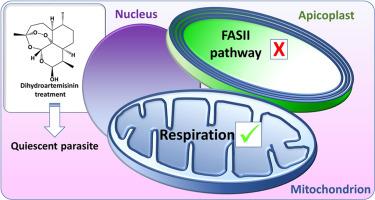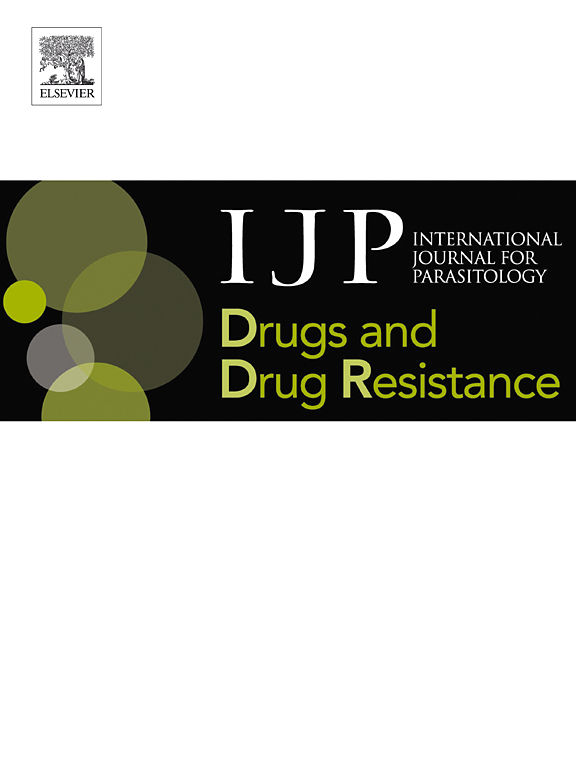In artemisinin-resistant falciparum malaria parasites, mitochondrial metabolic pathways are essential for survival but not those of apicoplast
IF 3.4
2区 医学
Q1 PARASITOLOGY
International Journal for Parasitology: Drugs and Drug Resistance
Pub Date : 2024-09-19
DOI:10.1016/j.ijpddr.2024.100565
引用次数: 0
Abstract
Emergence and spread of parasite resistance to artemisinins, the first-line antimalarial therapy, threaten the malaria eradication policy. To identify therapeutic targets to eliminate artemisinin-resistant parasites, the functioning of the apicoplast and the mitochondrion was studied, focusing on the fatty acid synthesis type II (FASII) pathway in the apicoplast and the electron transfer chain in the mitochondrion. A significant enrichment of the FASII pathway among the up-regulated genes in artemisinin-resistant parasites under dihydroartemisinin treatment was found, in agreement with published transcriptomic data. However, using GC-MS analyzes of fatty acids, we demonstrated for the first time that the FASII pathway is non-functional, ruling out the use of FASII inhibitors to target artemisinin-resistant parasites. Conversely, by assessing the modulation of the oxygen consumption rate, we evidenced that mitochondrial respiration remains functional and flexible in artemisinin-resistant parasites and even at the quiescent stage. Two novel compounds targeting electron transport chain (ELQ300, ELQ400) efficiently killed quiescent artemisinin-resistant parasites. Therefore, mitochondrial respiration represents a key target for the elimination of artemisinin-resistant persistent Plasmodium falciparum parasites.

在耐青蒿素的恶性疟原虫中,线粒体代谢途径对寄生虫的存活至关重要,但细胞质代谢途径则不然
寄生虫对一线抗疟药青蒿素的抗药性的出现和蔓延威胁着根除疟疾的政策。为了确定消除青蒿素抗药性寄生虫的治疗目标,研究人员对细胞质和线粒体的功能进行了研究,重点是细胞质中的脂肪酸合成 II 型(FASII)途径和线粒体中的电子传递链。研究发现,在双氢青蒿素处理下,青蒿素抗性寄生虫的上调基因中,FASII途径的基因明显丰富,这与已发表的转录组数据一致。然而,通过对脂肪酸的气相色谱-质谱分析,我们首次证明 FASII 通路是无功能的,这就排除了使用 FASII 抑制剂来抑制青蒿素抗性寄生虫的可能性。相反,通过评估耗氧率的调节,我们证明线粒体呼吸在青蒿素抗性寄生虫体内,甚至在静止阶段仍具有功能性和灵活性。两种针对电子传递链的新型化合物(ELQ300 和 ELQ400)能有效杀死静止期的青蒿素抗性寄生虫。因此,线粒体呼吸是消灭耐青蒿素持久性恶性疟原虫的关键目标。
本文章由计算机程序翻译,如有差异,请以英文原文为准。
求助全文
约1分钟内获得全文
求助全文
来源期刊

International Journal for Parasitology: Drugs and Drug Resistance
PARASITOLOGY-PHARMACOLOGY & PHARMACY
CiteScore
7.90
自引率
7.50%
发文量
31
审稿时长
48 days
期刊介绍:
The International Journal for Parasitology – Drugs and Drug Resistance is one of a series of specialist, open access journals launched by the International Journal for Parasitology. It publishes the results of original research in the area of anti-parasite drug identification, development and evaluation, and parasite drug resistance. The journal also covers research into natural products as anti-parasitic agents, and bioactive parasite products. Studies can be aimed at unicellular or multicellular parasites of human or veterinary importance.
 求助内容:
求助内容: 应助结果提醒方式:
应助结果提醒方式:


